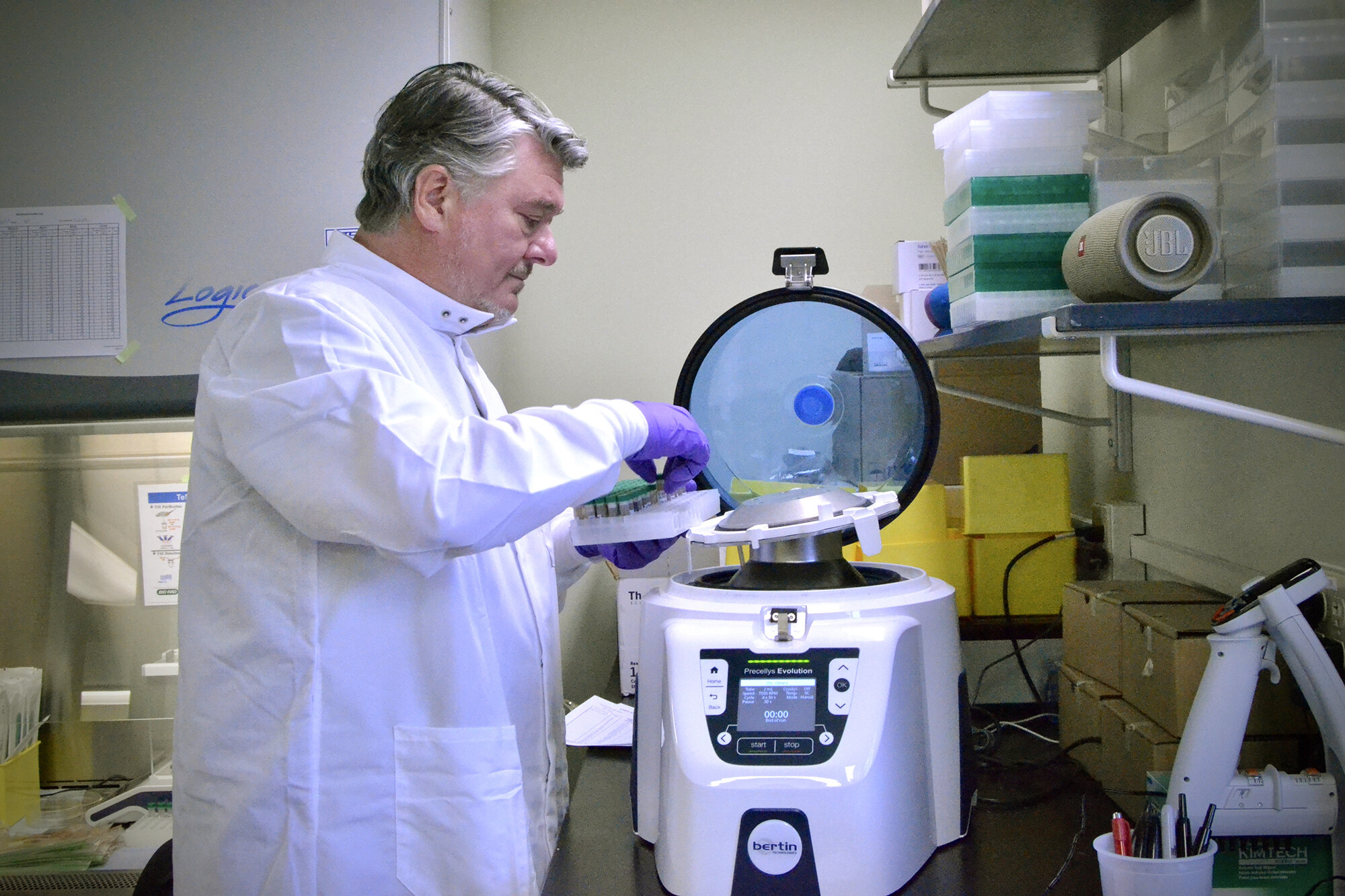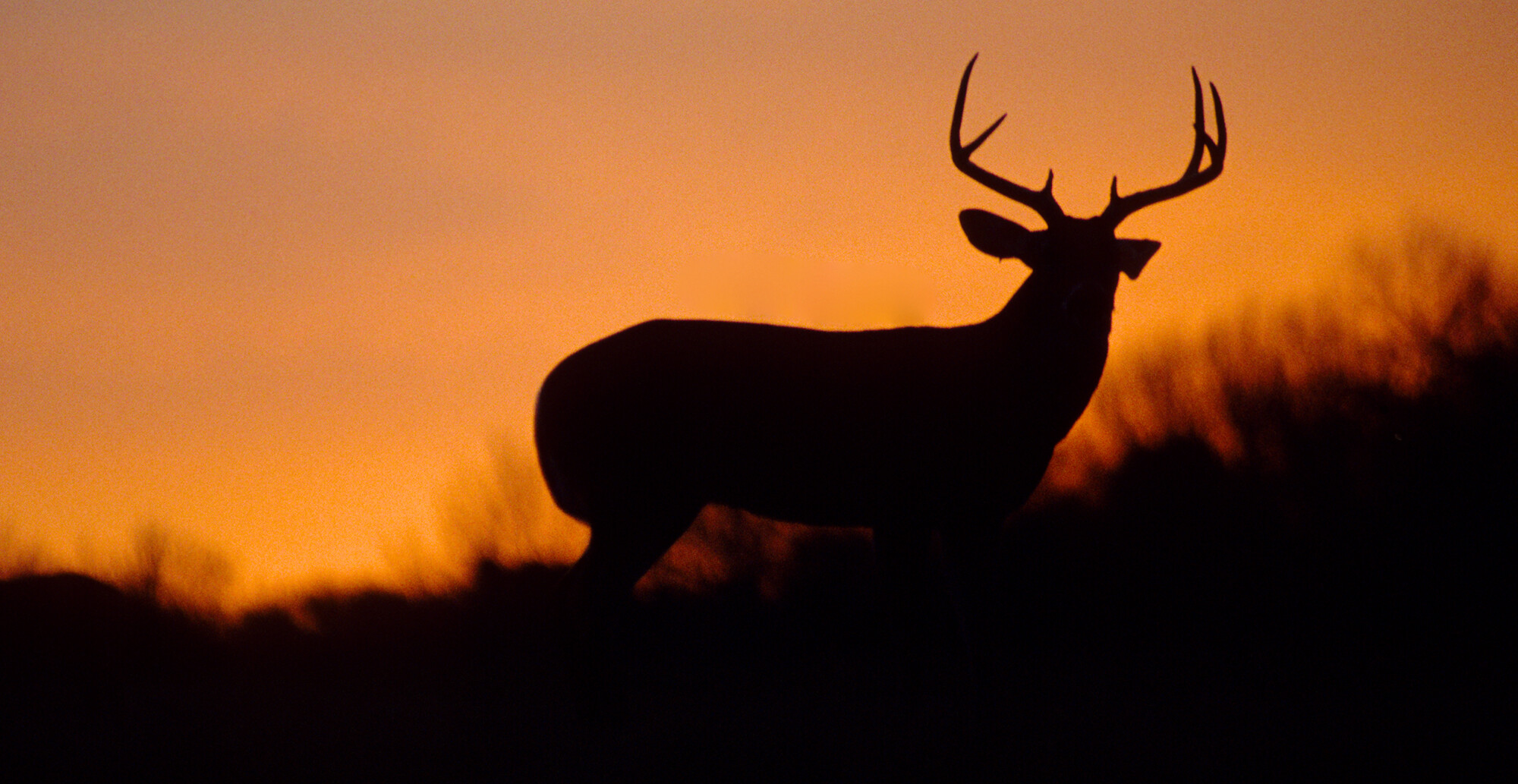
(From left) Doctoral student Hannah Yamagata, research assistant professor Kushol Gupta, and postdoctoral fellow Marshall Padilla holding 3D-printed models of nanoparticles.
(Image: Bella Ciervo)

When wildlife biologist Matthew Schnupp began his career, the emphasis was on conserving habitat.
“The paradigm of wildlife management for the last 20 years has been habitat management,” he says, aiming to conserve the land and ecosystems animals require to thrive.
And while protecting habitat in the face of an expanding human population remains a critical priority, he sees a new paradigm emerging as infections like chronic wasting disease, white-nose syndrome, and West Nile virus take a toll on animals and the people who value them.
“I would venture to say that, in the next 20 to 30 years, the new model for management will be ensuring the resiliency of wildlife populations through wildlife health issues,” says Schnupp, director of the Pennsylvania Game Commission’s (PGC) Wildlife Management Bureau.
That’s where Penn’s animal health expertise comes in.
In a new partnership, the School of Veterinary Medicine and the PGC have united to support a common cause: protecting the health of wildlife populations across the state. The Pennsylvania Wildlife Futures Program, established last year with $10 million in seed funding over five years from the PGC, charts a way forward for wildlife professionals who aim to safeguard animals from health threats—a goal that has knock-on benefits for humans and domestic animals as well. Co-led by Penn Vet’s Julie Ellis, an ecologist, and Lisa Murphy, a veterinarian and toxicologist, together with Schnupp, the program enables the School to hire new staff dedicated to wildlife health who will work with PGC employees to monitor disease threats, develop research projects, enhance communication and public engagement around wildlife health issues, and respond to challenges as they arise.
“Wildlife health is just so complex,” says Ellis, who directs the Northeast Wildlife Disease Cooperative, a network of institutions that provides diagnostics services and other expertise to fish and wildlife agencies in 10 states. “It involves, by necessity, multiple disciplines. You need modelers, you need epidemiologists, you need virologists, and on and on. State wildlife agencies generally don’t have those types of people on their staff. Through this program, we’re working with the Game Commission to identify its needs and help it get ahead of some of the problems wildlife diseases can bring.”
Murphy, who serves as director of the New Bolton Center lab that is part of the three-part Pennsylvania Animal Diagnostic Laboratory System (PADLS), says the program is enabling the School to create new areas of strength while leveraging what’s already in place at PADLS, Penn Vet, and the larger Penn community.
“It’s really been wonderful to be able to say that we have the basic resources, personnel, and capacity to establish this program,” she says, “but also to identify what we need to do the work even better. We’re building on established expertise here while bringing in new expertise with the support from PGC. That’s what is going to make this effort really special.”
The foundation of the new program lies in the complementary backgrounds of its three leaders: Ellis, Murphy, and Schnupp.
Ellis joined Penn Vet in the fall of 2018. In her previous role at Tufts University’s Cummings School of Veterinary Medicine, she established and ran the Northeast Wildlife Disease Cooperative (NWDC), which she continues to direct from Penn. Upon arriving in Philadelphia, she aimed “to bring wildlife health and disease opportunities, especially research opportunities, to the students and faculty.”
Murphy, a Penn Vet alum who has served on the faculty since 2005, had worked with Ellis for years as part of the NWDC. With a long-standing interest in wildlife issues and expertise in toxicology, she also has worked closely with the PGC and other state agencies through the PADLS New Bolton Center’s diagnostics work.
Schnupp, like Ellis, is relatively new to Pennsylvania. He took the bureau director position in January 2018 after a lengthy tenure managing wildlife on a private ranch in Texas, where issues like chronic wasting disease took up the majority of his time. Upon getting to know the Game Commission’s operations and priorities, he quickly discovered that the agency’s lone wildlife veterinarian, even while acting in concert with wildlife biologists, lacked the bandwidth to effectively confront a mounting tally of health and disease issues. As Schnupp started to envision a broader program to address these needs, he and Ellis got in touch, looped in Murphy and and began developing a plan to work together.
The first target of Wildlife Futures was a no-brainer; it has emerged as the priority demanding the lion’s share of Schnupp’s time and attention, not to mention the agency’s money. That’s chronic wasting disease (CWD). Spread by misfolded proteins called prions, CWD causes a contagious and fatal illness in deer. Though CWD has been a problem in states in the West and Midwest for a few decades, it’s a relatively new problem in Pennsylvania, where the first CWD-positive deer was found in 2012.
“CWD is such a hot topic in Pennsylvania,” says Ellis. “The disease’s spread has been difficult to control. It’s also a challenging disease politically because one of the preferred management techniques to control it is culling, and that’s a very unpopular thing to do in a state that sells the second most hunting licenses in America.”

There’s also a lot of “confusion and misinformation and fear” surrounding the disease, notes Murphy. While no human cases have been documented, some scientists believe that such a leap from wildlife to human is possible. As a result, many hunters submit samples of the deer they kill for CWD testing before they consume the meat. The demand for testing had overwhelmed the PGC, and test results were taking weeks or even months to come back.
“It was clear from talking with hunters that expediting the time it took to provide them CWD test results was tremendously important,” Schnupp says. “That heightened its priority status for us. We addressed the delay head-on, finding more timely ways to test and notify successful deer hunters who submitted samples.”
To Schnupp, CWD was the low-hanging fruit for the fledgling Futures program. And Penn Vet wasted no time in responding. In less than six months, in an effort led by Michelle Lucey Gibison, a new, USDA-accredited lab space for CWD testing was established at New Bolton Center, opening in December. The increased testing capacity aims to offer the PGC and hunters results back in 7 to 10 days, with the ability to track test results online.
In addition, through Wildlife Futures, PGC, Penn Vet scientists, and others are working collaboratively to devise a science-backed response plan for CWD management that takes into account what is happening in other state agencies both within and outside Pennsylvania.
“Wildlife health issues don’t respect state boundaries,” Schnupp says. “Wildlife Futures is an opportunity to collaborate on research and surveillance. That’s important because we’re not an island.”
While CWD spurred the program’s earliest actions, it’s far from the only challenge in its sights. White-nose syndrome, for one, has decimated the state’s bat populations since it was first detected in Pennsylvania in 2008. PGC bat biologist Greg Turner is renowned for his years of research into the fungal disease, and his attempts at control and intervention. The partnership with Penn may lend even more support to those efforts.
And for the state bird, the ground-nesting ruffed grouse, Schnupp is hopeful that Penn Vet can expand on the research of biologist Lisa Williams, whose studies have identified West Nile virus as a major threat to the popular game species.
“Typically biologists are trained to think, well, wild animals die and it’s a part of the natural cycle,” says Ellis. “But with things like white-nose syndrome, West Nile virus, and even chytrid fungus in amphibians, we’re realizing that these diseases are really serious, and have the ability to wipe out local populations and in some cases entire species.”
Other current disease threats, from mange in black bears, to lead poisoning in bald eagles, to rabies in raccoons, and beyond, may receive research attention and diagnostic support through the program in years to come.
The leadership team is planning for the challenges that belong to the future as well. First by hiring: In total a dozen employees across PGC and Penn will be dedicated to the Wildlife Futures Program. For its part, Penn Vet is in the process of bringing on a wildlife pathologist and a wildlife disease ecologist, who will be based at New Bolton Center, and a wildlife communications liaison, who will work at the PGC headquarters office in Harrisburg and act as “eyes and ears on the ground” to ensure Penn Vet’s work is supporting the needs of the agency, says Ellis, and communicating the outcomes of that work to different stakeholder groups, including the public.
“This is more than just providing a service or completing a project,” adds Murphy. “It’s a program that will be lasting. We’re assembling a team that will be excited to be on the front lines of what’s next—what are the emerging disease concerns for Pennsylvania and the region— and to put us in the best possible position to tackle them.”
In addition to recruiting new personnel, the Wildlife Futures Program will build a wildlife tissue bank to store blood, feather, fur, and other samples from wildlife of all kinds to ensure they are properly archived for later research and analysis.
“Let’s say we identify a disease that we haven’t seen previously,” says Murphy. “We could go to that tissue archive and see, was it present in samples we collected five, 10, 20 years ago?”
As the program progresses and builds, Ellis and Murphy hope to offer opportunities for student engagement. That might begin with a graduate or undergraduate student from Penn analyzing samples that the PGC has on hand from, say, ruffed grouse serum and feathers, but could morph as new Penn Vet faculty build their research programs in wildlife disease.
For now, Schnupp, Murphy, and Ellis aren’t putting a limit on their ambitions for the program. “I think we’re going to be setting the national stage for wildlife health issues,” Schnupp says. “I firmly believe that.”
Their hope is that all residents of the Commonwealth will reap the benefits.
“There are some real opportunities here in terms of preserving wildlife and the environment they live in as a resource that all people can appreciate and enjoy,” says Murphy. “Whether you hunt, enjoy having wildlife in your backyard, or just appreciate knowing that there are wild areas out there, this program is supporting the health of those animals and those wild places. It really is all tied together.”
Julie Ellis is an adjunct associate professor in pathobiology at the University of Pennsylvania School of Veterinary Medicine.
Lisa Murphy is an associate professor of toxicology and director of the Pennsylvania Animal Diagnostic Laboratory System-New Bolton Center at the University of Pennsylvania School of Veterinary Medicine.
Matthew Schnupp is director of the Pennsylvania Game Commission’s Bureau of Wildlife Management.
Homepage photo: The goal of the program, the leaders stress, is to safeguard wildlife health for all Pennsylvanians, “whether you hunt, enjoy having wildlife in your backyard, or just appreciate knowing that there are wild areas out there,” says Penn Vet’s Lisa Murphy.
Katherine Unger Baillie

(From left) Doctoral student Hannah Yamagata, research assistant professor Kushol Gupta, and postdoctoral fellow Marshall Padilla holding 3D-printed models of nanoparticles.
(Image: Bella Ciervo)

Jin Liu, Penn’s newest economics faculty member, specializes in international trade.
nocred

nocred

nocred